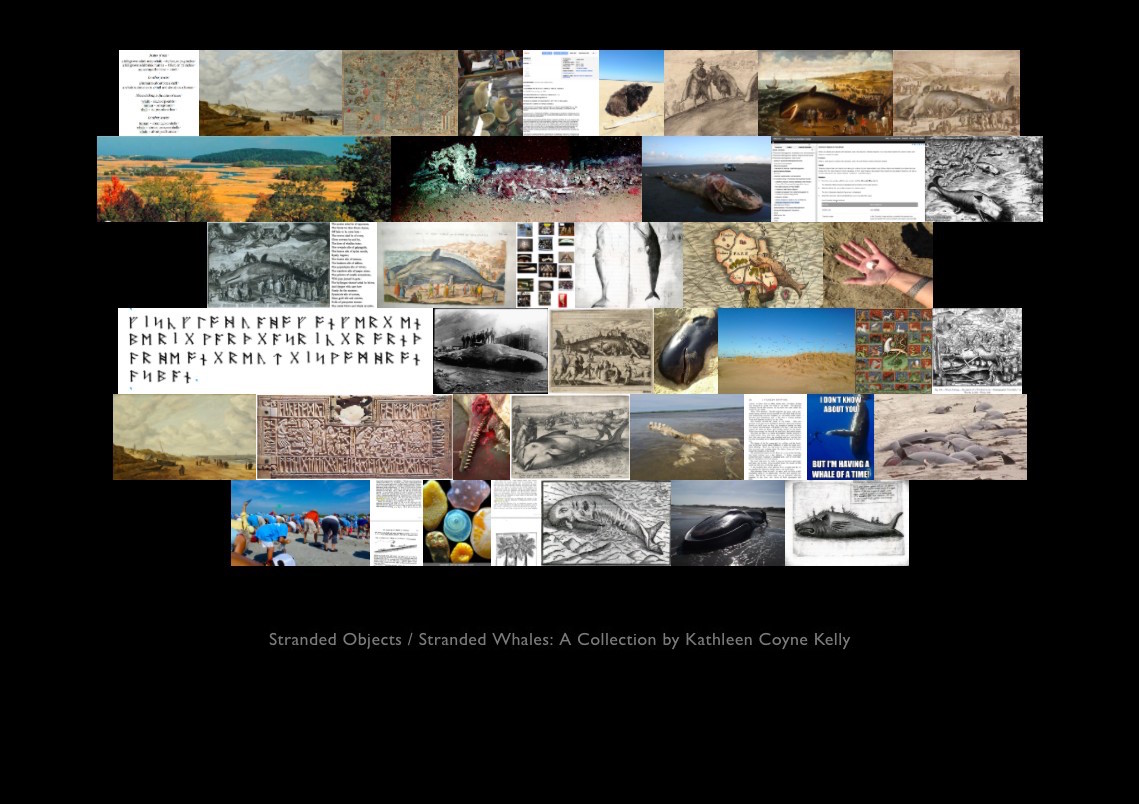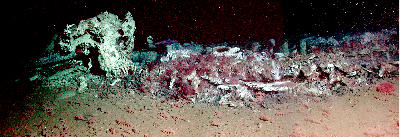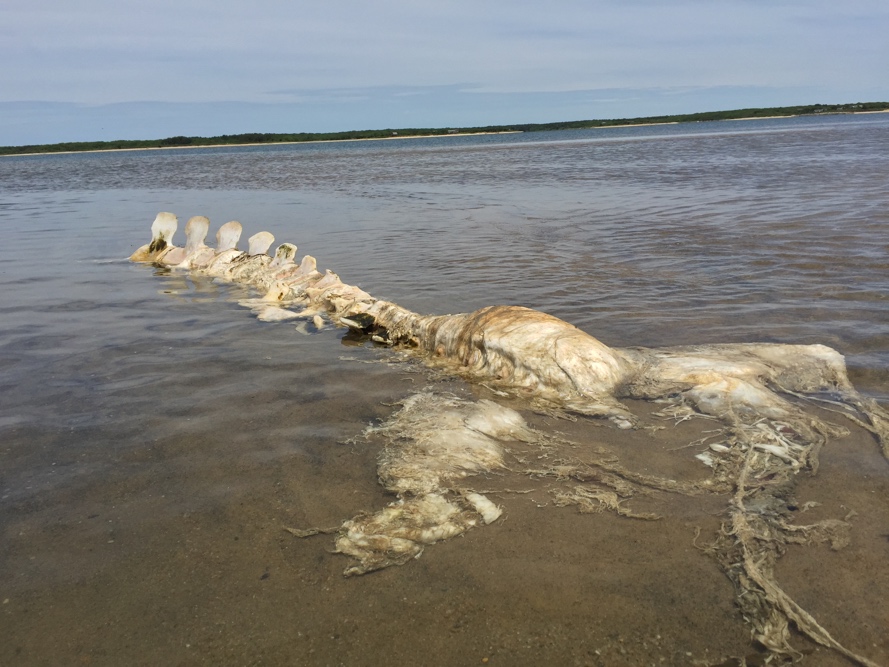Stranded Objects / Stranded Whales
or The Whale’s Tooth
Kathleen Coyne Kelly

My collection is focused on stranded
whales, representations of stranded whales, and objects made from whale
parts, including scrimshaw, the eighth-century Franks Casket, and two antique
carved whale’s teeth that sit on my desk. My title riffs on Eric Santner’s notion of the stranded object, that “tiny spark of contingency,” as Benjamin
says, which Santner reads “as an index of a
historical opportunity that was left unrealized but that still remains
available as a sort of energy potential that continues to dwell in history”
(1990, 153). In this context, the stranded whale and its parts might have, in
some elsewhere and elsetime,
evaded human consumption and design, might have become something else — such as
whale fall, a complex underwater
ecosystem comprised of a cetacean carcass and its deep-sea inhabitants.
 Whale fall
Whale fall
Humans aren’t the only ones who interact/intra-act with dead whales and their parts.
Whale fall is the term given to the complex ecosystem that develops when a dead whale body sinks to the sea floor
at depths of 6600 feet or more. Whale falls are home to all sort of sea creatures: bristleworms,
crabs, giant isopods, hagfish, lobsters, mussels, prawns, sea cucumbers,
shrimp, sleeper sharks, squat lobsters. (In shallower waters, the whale
carcass is consumed by scavengers.)
Whale fall — it’s Miltonian:
one sees the huge body, life extinguished — natural causes? too many close
encounters with the prows and propellers of human-piloted ships? — the
blue-black body in slow-motion, dropping, drifting, end over end, finally
settling on the deep ocean floor, sand and debris (most likely the remains of
other, smaller fallen bodies) rising in languid clouds in the dark.
While an implicit narrative organizes the texts and images, this assemblage is also characterized by a certain serendipitous randomness — a contingency — inherent in any sort of hunting and gathering. Visiting flea markets, garage sales, junk stores, antique shops, even garbage-picking, and certainly beachcombing, are exercises in surprise.
Searching, one assigns value to something one didn’t even know one wanted until seeing the thing and surrendering to the tactile, hefting the object in the hand and stroking its smooth or rough or cold or warm or plush or threadbare surface. The desire to possess has nothing to do with need or utility. However, like Proust’s exquisite madeleine, collecting may have everything to do with recuperating memory and imagining the self. One of the appeals of eBay is that one can find and re-possess the artifacts of one’s childhood: Grandma’s Pyrex casserole dish, the Barbie with the bubble cut. I want to stress the tactile: owning a photograph of a seashell or a Barbie doesn’t work. One needs the thrill of contact to evoke the memory of an earlier self. Imagining an other or better or more beautiful or richer self by proxy of ownership is the very stuff of consumer capitalism.
 My hand makes a sea-monster shadow. The shadow’s bumps and dips
echo the nubbed surface of the spiny Florida jewelbox clam (Arcinella cornuta, family Chamidae).
My hand makes a sea-monster shadow. The shadow’s bumps and dips
echo the nubbed surface of the spiny Florida jewelbox clam (Arcinella cornuta, family Chamidae).
Anthropocentrically speaking, the ratio of a human to a one-inch seashell is 70:1. Surprise constructs the beach’s
allure, in part, of course, because the seashore changes over the seasons and
daily with the tides. Fantasy also contributes to shore-love: maybe today,
surely, one will happen upon a half-submerged chest of doubloons, or a message in a bottle will roll up out of the surf; maybe
today a smiling or fierce or simply lost and bewildered mermaid will rise out
of the foam. Maybe today, that perfect stone or shell or piece of driftwood
or bone or anything else the ocean leaves behind will fall into the hand. Beach drift, it’s called — everything
that collects at the tide line.
Here, however, with whales in mind, I look up from the wave’s edge to explore the surprise of the oversize — what doesn’t fit into the hand: the fifteen-ton sperm whale stranded on the beach, depicted and described in the Middle Ages and now.
Over the past several years, I’ve had a few encounters with whales, living and dead, in their entirety and in their parts. These experiences inspired me to scale up my beachcombing to focus on the huge, the colossal, the gigantic — that is, in human terms. There are no giants in nature. (I’m paraphrasing Susan Stewart on the miniature in On Longing, 1993, 55.)
 Chilmark Pond, 2015
Chilmark Pond, 2015
In the summer after the Big Snow of 2015, I kayaked across
Chilmark Salt Pond. The winter storms had breached the barrier beach, and, at
high tide, the ocean was rushing into the salt pond, pouring through a narrow
opening. Such breaches are good for salt ponds and keeps them from getting
too stagnant. This time, we saw two huge forms in the shallow water of the
pond. What were they? As we paddled closer, the shapes resolved into two
whale carcasses. One was old, nothing but the cleaned bones of huge
vertebrae. The other still had flesh on it, slowly waving in the water’s
current. The carcass was actually half a whale, clean cut off, a row of
vertebrae and the tail remaining. Perhaps it had been cleaved in two by a
ship. Instead of sinking to the ocean floor, the whale’s severed body had
been washed into the pond. Only the illegality of harvesting whale parts
prevented me from lifting a vertebrae the size of a
footstool into my boat and taking it home. As I accumulated, sorted, and
arranged images, texts, and ideas for this project, I came to realize that my
quest had no end, especially after I decided to beachcomb the web using the
search term stranded object and taking
screen shots. Collecting, then, is also an exercise in incompleteness: one
obsesses on what one doesn’t have.
There is pleasure in the undone, the unfound — the mise
en abyme of desire. If I had drilled down a few
more pages on the net, who knows what stranded treasure I would have
discovered? The Net is also an ocean: could I ever cast a wide enough net to
capture everything? Moreover, after I said “finished,” I kept collecting,
often through sheer serendipity: I met a nine-year-old on the street who was
proudly carrying home a small wooden trunk that he made at school. He had
painted a whale on it, and added in shaky lettering, thar she blows!
I read Raphael Carter’s cyberpunk novel, Fortunate
Fall, which features a whale. The Middle Shore project is not intended to
be complete: readers, viewers, and listeners can add to any collection,
express their own delight in beachcombing — and then I can have what you
have.
Collecting is also an exercise in decontextualizing — a given object is pulled from someone else’s life, some other historical-cultural moment, and re-placed in one’s own life. A bust of Beatrice sits next to a dragon puppet on a shelf. An Il Dottore mask is nailed to the wall above crammed with bird figurines. With respect to natural things, either in their original found state or as they are shaped by the human hand, how far does such decontextualizing go? How does collecting shells or bones or driftwood — dead parts of once-living entities — gather nature into culture? Like Adam naming the animals, does collecting parts of living things serve as an exercise in dominion?
 Penguins at Jane Slater’s Oversouth Antiques. The ethics of collecting first
emerged as a question for me when I bought two whale’s teeth carved into the
shape of penguins. The visual attraction was instant — but holding the teeth in
my hand was even more compelling. The teeth feel slightly ribbed, massy, cool
to the touch. One’s thumb caresses, following the direction of the sailor’s
scraping tool as he created the flippers and the feet and turned the pointed
tip of the tooth into a suggestion of a beak. My pleasure in the teeth
continues, partial and ambivalent, sensuously satisfying but ethically
disturbing. While some species of birds and rats collect random and often
shiny objects, what other creature besides homo sapiens collects the body
parts of other creatures?
Penguins at Jane Slater’s Oversouth Antiques. The ethics of collecting first
emerged as a question for me when I bought two whale’s teeth carved into the
shape of penguins. The visual attraction was instant — but holding the teeth in
my hand was even more compelling. The teeth feel slightly ribbed, massy, cool
to the touch. One’s thumb caresses, following the direction of the sailor’s
scraping tool as he created the flippers and the feet and turned the pointed
tip of the tooth into a suggestion of a beak. My pleasure in the teeth
continues, partial and ambivalent, sensuously satisfying but ethically
disturbing. While some species of birds and rats collect random and often
shiny objects, what other creature besides homo sapiens collects the body
parts of other creatures?
In this respect, collecting is also an exercise in redemption; the collector, as John Clifford says: “discovers, acquires, salvages objects” (1985, 239). One may feel that one is saving a thing from loss or destruction. Perhaps such a belief is only a pretext. Susan Stewart, for example, argues that the museum offers “an illusion of a relation between things” which “takes the place of a social relation” (1993, 165). Baudrillard describes “the environment of private objects and their possession” as “essential as dreams” ([1968] 2005, 103). Moreover, a museum of natural history or one’s own cabinet of curiosities may well be testaments to a stranded human desire for, as Thoreau says, “Contact! Contact!” with the more-than-human world. This is, I am aware, the most benign reading to be made to explain our desire — located in the visual, the tactile, and in the ebb and flow of the emotions — for things given by — or stolen from — the sea.
Kathleen Coyne Kelly
Department of English
Northeastern University
References
Barthelmess, Klauss. 2003. Stranded whales in the culture and economy of medieval and early modern Europe. ISANA 27: 1 — 4. http://www.whaling.jp/english/isana/no27_02.html.
Baudrillard, Jean. [1968] 2005. Le Système des objets. The System of Objects. Trans. James Benedict. 2nd ed. London and New York: Verso.
Callahan, James. 2001. The Ins and Outs of Ivory Law. Interview for The Antiques Roadshow (PBS Television). http://www.coupdefoudre.com/Ivory.html.
Chevalier, Jim. 2014. Whaling in Medieval France. Les Leftovers. http://leslefts.blogspot.com/2014/01/whaling-in-medieval-france.html
Clifford, John. 1985. Objects and Selves — An Afterword. In Objects and Others: Essays on Museums and Material Culture, 236-246. Ed. George Stocking, Jr. History of Anthropology 3. Madison, WI: University of Wisconsin Press.
Fox, Denton and Hermann Pálsson, trans. 1974. Grettir’s Saga. Toronto, ON: University of Toronto Press.
Fulton-Bennett, Kim. Whale falls — islands of abundance and diversity in the deep sea. MBARI - Monterey Bay Aquarium Research Institute. http://www.mbari.org/whale-falls-islands-of-abundance-and-diversity-in-the-deep-sea/.
Goldman, Victoria Sears. 2012. “Omen and Oracle”: Dutch Images of Beached Whales. http://www.victoriasearsgoldman.com/16th-17th-century-dutch-images-beached-whales/.
Halliwell, H.O., ed. 1855. Early English Miscellanies in Prose and Verse, Selected from an Inedited Manuscript of the Fifteenth Century (Porkington MS.). London: Wharton Club.
Hollander, John. 1975. Vision and Resonance: Two Senses of Poetic Form. Oxford, UK: Oxford University Press.
Hough, Carol and John Corbett. 2013. Beginning Old English. New York: Palgrave.
Kennedy, Maev. 2014. Restoration reveals hidden whale in 17th-century Dutch painting. The Guardian, June 4: http://www.theguardian.com/artanddesign/2014/jun/04/restoration-hidden-whale-dutch-painting.
Kunz, Keneva, trans. 2008. Eirik The Red’s Saga. In The Vinland Sagas, with an introduction and notes by Gísli Sigurdsson. London and New York: Penguin.
Larsen, Lawrence M., trans. 1935. Gulathing Law, The Earliest Norwegian Laws; Being the Gulathing Law and the Frostathing Law. New York: Columbia University Press.
“Lovely lordynges, ladys lyke.” Early English Miscellanies in Prose and Verse, Selected from an Inedited Manuscript of the Fifteenth Century (Porkington MS.). Ed. H. O. Halliwell. Wharton Club, II. 1 — 6, 4. (1855).
Santner, Eric L. 1990. Stranded Objects: Mourning, Memory, and Film in Postwar Germany. Ithaca, NY: Cornell University Press.
Stewart, Susan. 1993. On Longing: Narratives of the Miniature, the Gigantic, the Souvenir, the Collection. Durham, NC: Duke University Press.
Szabo, Ellen. “Bad to the bone”? The Unnatural History of Monstrous Medieval Whales, The Heroic Age 8 (2005): http://www.heroicage.org/issues/8/szabo.html.
Van Duzer, Chet. 2003. Sea Monsters on Medieval and Renaissance Maps. London: The British Library.
Webster, Leslie. 2012. Anglo-Saxon Art. London: British Museum Press.
---. 1991. The Franks Casket. In The Making of England: Anglo-Saxon Art and Culture, AD 600 — 900, ed. Leslie Webster and Janet Backhouse. Toronto, ON and Buffalo, NY: University of Toronto Press.
Weiss, Robert. 2010. About Ivory. http://www.marinearts.com/Pages/rwivory.htm.
Whitty, Julia. 2010. Two Whales, 400 Years Apart. Mother Jones, November 10: http://www.motherjones.com/blue-marble/2010/11/two-whales-400-years-apart.